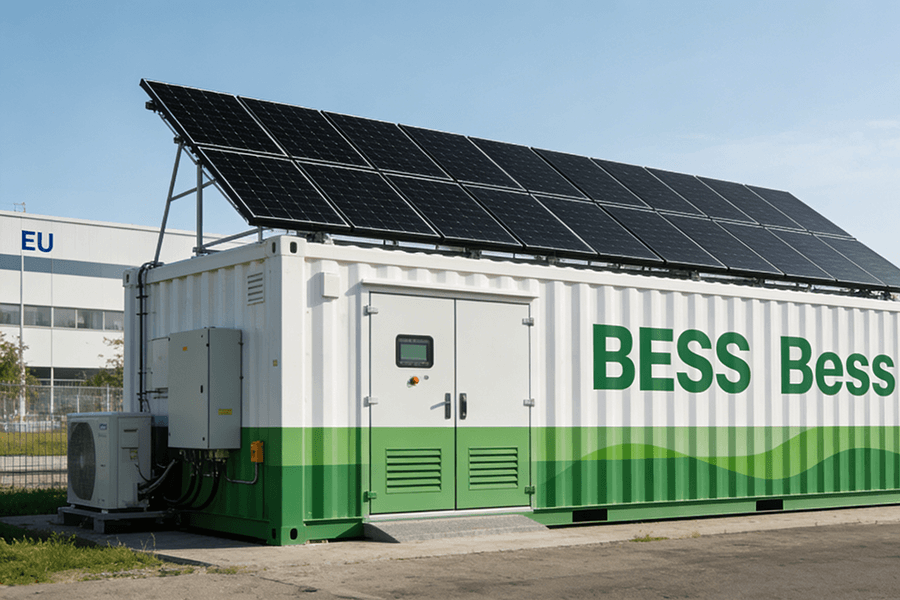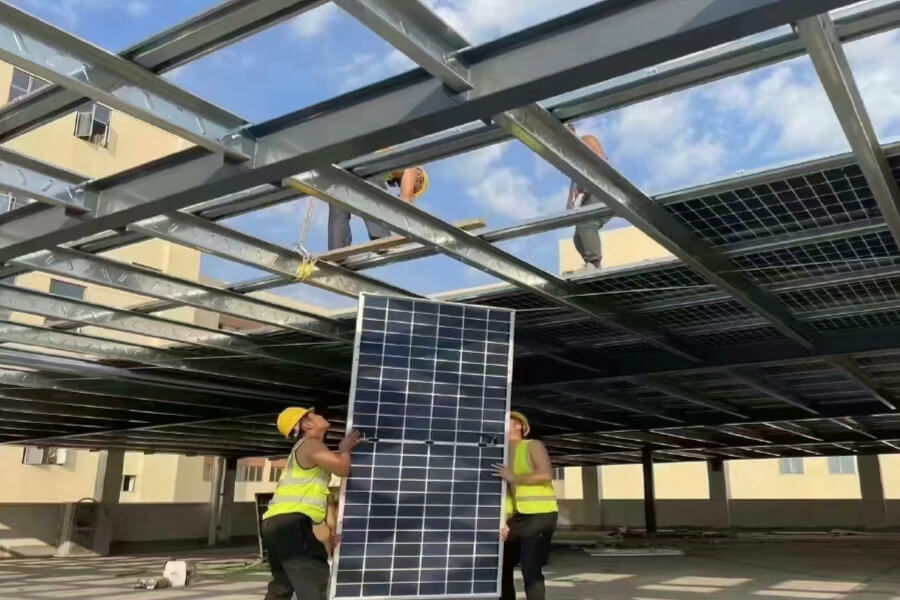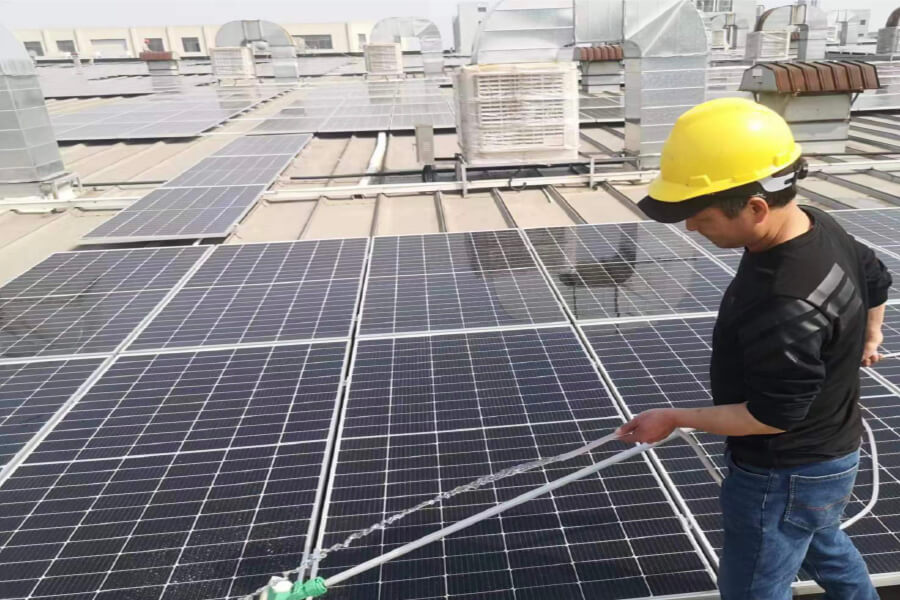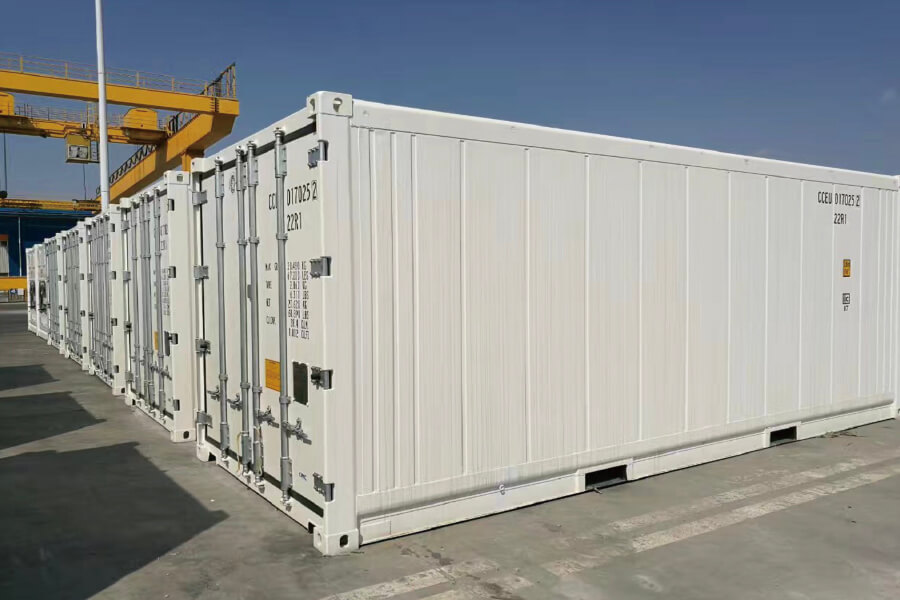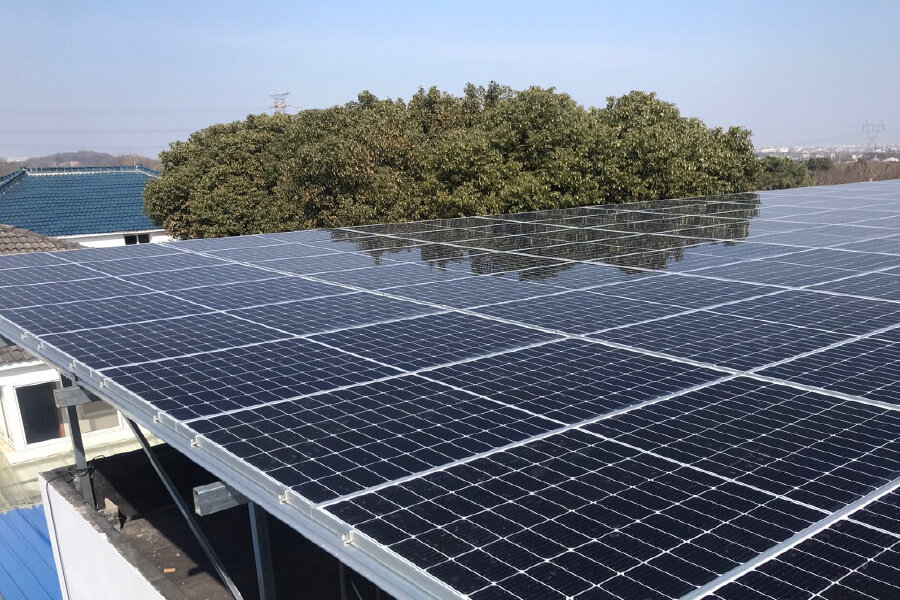Influencing factors:
How much solar for 50kWh per day? To determine what capacity solar system is needed to produce 50 kWh of electricity a day, a number of factors need to be considered, including the geographic location of the installation site, lighting conditions, and system efficiency.
1. geographic location
Geographic location is an important factor. Different regions have different sunlight hours and light intensity, which will directly affect the power generation of the solar system. For example, in the low latitude near the equator, the sun is abundant, the sunshine time is long, the same capacity of the solar energy system can produce more electricity.
2.Lighting conditions
Lighting conditions affect the amount of electricity generated by a solar system. For example, cloudy, overcast or foggy weather can affect the intensity of the sun’s radiation and reduce the efficiency of the solar system. Therefore, changes in lighting conditions need to be taken into account when calculating the required solar system capacity.
3. System efficiency
System efficiency an important factor. The efficiency of a solar power system usually refers to the percentage of solar energy that is converted into electricity. A highly efficient solar power system can produce more electricity for the same amount of light. Different types of solar systems have different efficiencies. Grid-connected solar systems have the highest conversion efficiency, which can reach 98%, hybrid solar systems can reach more than 90%, and off-grid solar systems have a relatively low conversion efficiency, which is usually around 85%.
There are many factors affecting the power generation efficiency of solar systems, and the following is an analysis of the main factors.
a. Impact of components on the power generation efficiency of solar systems
For the same power of solar modules, monocrystalline silicon modules have higher conversion efficiency than polycrystalline silicon modules;
For the same power solar module, N-type solar cell module has higher conversion efficiency than P-type solar cell module;
For solar modules of the same power, bifacial solar modules have a higher conversion efficiency than monofacial solar modules;
For the same power of solar modules, the conversion efficiency of half-cut process modules is higher than that of traditional process modules.
b. Influence of inverter on power generation efficiency of solar system
For the same power inverter, the conversion efficiency of high frequency inverter is higher than that of industrial frequency inverter;
For the same power inverter, the conversion efficiency of inverter with multi-level process is higher than that of inverter with single-level process.
c. Impact of solar system maintenance and operation process on solar system power generation efficiency
-
- Whether to clear the dust and snow on top of the solar panels in time.
- Whether to check the shadow shading in time to avoid affecting the power generation of solar panels.
- Whether to check the resistance to ground of solar panels in time to check whether there is any leakage of electricity.
All these factors affect the conversion efficiency of the solar system and the amount of power generated by the solar system.
In summary, to determine how much capacity PV power generation system is needed to generate 50 kWh of electricity in a day, it is necessary to consider factors such as geographic location, light conditions, and system efficiency. In practice, solar power systems need to be designed and optimized according to local climatic conditions and load demand to meet the power demand.
Specific calculations:
For different customer needs, Maxbo will provide different types of solar system solutions, which are categorized as grid-connected solar system, hybrid solar system and off-grid solar system below, with actual specific cases to illustrate how much capacity is needed for each different solar system that can generate 50 kWh of electricity.
Grid Tied Solar System Example – 10KW
Base case:
Solar system installed in the Maldives, can be connected to the public grid, the customer does not self-consumption, as long as the sale of electricity to the local grid, the local solar power peak sunshine hours of 4.6 hours. Voltage 230V, frequency 50Hz, PV panels roof mounted.
Design Basis
The customer only needs to sell electricity, so the system is a grid-connected solar system, the grid-connected system’s power generation efficiency is about 98%, i.e., the amount of power generated per day is
50kWh / 98% = 51.02 kWh.
The local peak power generation time is 4.6 hours, so the PV panel power of the solar system is
51.02kWh / 4.6h = 11.09kW.
The Growatt grid-tie inverter MIN 10000 TL-X and Jinko 550w solar panel JKM550M-72HL4 are selected and the product specification sheet is given below:


The inverter MIN 10000 TL-X has Maldives grid connection certification and can be connected to the local grid to sell electricity. The rated AC output power of the inverter is 10kW, the maximum PV input power is 15kW, the inverter has built-in MPPT with PV input voltage range 60-550v, the MPPT has a total of 3 circuits with 1/1/2 strings in each circuit, the maximum power point current of each circuit is 13.5A/13.5A/27A, the maximum short circuit current of each circuit is 16.9A/16.9A/33.8A.
Jinko 550w solar panel JKM550M-72HL4 ,max power 550w, max power point voltage 40.90V, max power point current 13.45A, open circuit voltage 49.62V, short circuit current 14.03A.
Solar panel 7 series 3 parallel, each string open circuit voltage 7*49.62V=347.34V, each string maximum power point voltage 7*40.90V=286.3V, all in the inverter MPPT voltage input range of 60-550v: each string maximum power point current 13.45A, each string short-circuit current 14.03A. also in the inverter built-in MPPT maximum current limit. within the maximum current limit of the inverter’s built-in MPPT.
| Detailed configuration program | Qty |
|---|---|
| Jinko solar panel JKM550M-72HL4 | 21 pcs |
| growatt inverter MIN 10000 TL-X | 1 pc |
| 3 in 3 out converter box | 1 pc |
| PV panel roof mounting bracket | 1 set |
| MC4 Cable. | 200 meters |
| MC4 connectors | 10 pcs |
Based on the customer’s request in Maldives, this 10kW grid-tied solar system can produce 50kWh of electricity per day and earn revenue by selling the electricity. Photo of 7.5kW grid-connected solar system generating electricity shared by a customer in Maldives:

Hybrid Solar System Example – 12KW
Basic situation:
The solar system is installed in Hamburg, Germany, the customer’s main self-consumption, the solar system can be connected to the public power grid, the excess power is sold to the local power grid, the local solar power generation peak sunshine duration of 4.0 hours. The local voltage is 230V, frequency 50HZ, and the PV panels are roof-mounted. German law stipulates that the area of each roof-mounted solar panel cannot exceed 2 square meters.
Power consumption:
50kWh per day, 20kWh at night.
Load:
2 sets of air conditioners with 3 horsepower,
1 set of water pump with 3KW,
washing machine, computer,
TV,
oven and other small household appliances totaling 4KW,
total load power of 11KW.
System design basis:
Customers mainly for self-consumption, there is a need to sell excess power, so the system is a hybrid solar system, the system’s power generation efficiency is about 90%, that is, the amount of power generated per day is 50 / 90% = 55.55 kWh.
The local peak power generation time is 4 hours, so the PV panel power of the solar system is 55.55/4 = 13.88kW. Jinko 410w solar panel KM410N-54HL4-B 33pcs is selected. The product specification is shown in the figure below:

The rated power of the inverter should be slightly greater than the sum of the rated power of all the loads, and the total power of the PV panels should be less than the maximum PV input power of the inverter’s built-in MPPT, so as to ensure that the inverter can work stably, and to avoid damage to the equipment or unnecessary waste due to overloading and current limiting of the inverter.
The sum of the power of the load is 11kW, so you need to choose an inverter with a rated power greater than 11kW and a maximum PV input power of the MPPT greater than 13.88kW.
One Deye 12k inverter SUN-12K- SG04LP3-EU was selected. The product specification is shown in the figure below:

Commonly used energy storage devices include lithium batteries and gel batteries. Solar energy systems need to be paired with appropriate energy storage equipment to store the electricity produced during the day.
The capacity of the energy storage equipment should be selected according to the actual situation, and the capacity of the energy storage equipment should be slightly larger than the evening power consumption to ensure the demand for electricity at night.
Considering that the DOD of lithium batteries is generally 80%, it is necessary to choose an energy storage device with a capacity slightly larger than 20/0.8 = 25 kWh.
Select Maxbo 48V 100Ah lithium battery GBP48V-100AH-W 3 units. See below for product specifications

Deye 12k Inverter:
SUN-12K- SG04LP3-EU has German VDE 0126-1-1 grid connection certification and can be connected to the local grid to sell electricity.
The rated AC output power of the inverter is 12kw, the maximum PV input power is 15.6kW, the built-in MPPT PV input voltage range is 200-650v, the MPPT has a total of 2 circuits with 2/1 strings each, the maximum power point current of each circuit is 13A+13A/13A, the maximum short-circuit current of each circuit is 17A+17A/17A.
Jinko 410w solar panel:
KM410N-54HL4-B ,max power 410w, max power point voltage 31.66V,max power point current 12.95A, open circuit voltage 37.77V, short circuit current 13.68A.
Jinko 410w solar panel 11 series 3 parallel, open circuit voltage per string 11*37.77=415.47V, max power point voltage per string 11*31.66=348.26V, built-in in Deye 12k inverter
MPPT:
The voltage input range of MPPT is 200-650V; the power point current of 12.95A per string and the short circuit current of 13.68A per string are also within the maximum current limit of the inverter’s built-in MPPT.The voltage rating of Maxbo 48v100ah lithium batteries is 48V, and the working voltage range is 42-56.25V.
The voltage range of the batteries in Deye 12k inverter is within the voltage range (40-60V) of the batteries. range (40-60V) of the Deye 12k inverter.
Based on the requirements of the German customer, Maxbo supplied this 12KW hybrid solar system, which can produce 50KWH of power per day, and can support loads of up to 12KW. The excess power is stored in the batteries for back-up, and is available for use by loads at night or on cloudy or rainy days, and can be used as an emergency power source to supply important loads in case of a power outage on the public power grid. The excess power can be sold to the public grid for revenue.
| Detailed configuration program | Qty |
|---|---|
| Jinko solar panel KM410N-54HL4-B | 33 pcs |
| Deye inverter SUN-12K- SG04LP3-EU | 1 pc |
| Maxbo Lithium Battery GBP48V-100AH | 3 pc |
| 3-input, 3-output convergence box | 1 pc |
| PV panel roof mounting bracket | 1 set |
| MC4 cable | 200 meters |
| MC4 connectors | 20 pcs |
Off-Grid Solar System Example – 12KW
Basic Situation:
The solar system is installed in a resort on an island in Malaysia, there is no public grid on the island, the customer is now using a diesel generator to supply power to the resort, the local solar power peak sunshine hours of 5.3 hours. Voltage 230V, frequency 50HZ, photovoltaic panels installed on the roof.
Power consumption:
50KWH per day, including 20kWh at night.
Load:
7 sets of 1.5 horsepower air conditioners,
1 set of 1.5KW water pumps,
washing machines,
computers,
televisions and other small household appliances totaling 2.0KW,
the total power of the load 11.21KW.
System design basis:
The customer’s resort does not have a public grid and there is no demand for selling electricity, so the system is an off-grid solar system with a power generation efficiency of about 85%, i.e., the power generation required per day is 50 / 85% = 58.82 kWh.
The local peak sunshine time is 5.3 hours, so the total PV panel power of the solar system is
58.82kWh/5.3h = 11.10kW.
The Jinko 550W solar panel JKM550M-72HL4 20 pcs is selected, the product specification is shown in the figure below:

Jinko 550W solar panel JKM550M-72HL4 ,max power 550W, max power point voltage 40.90V, max power point current 13.45A, open circuit voltage 49.62V, short circuit current 14.03A.
The rated power of the inverter should be slightly larger than the sum of the rated power of all the loads, and the total power of the PV panels should be smaller than the maximum PV input power of the built-in MPPT of the inverter, so as to ensure that the inverter can work stably, and to avoid damaging the equipment or causing unnecessary waste due to the overloading and current limitation of the inverter.
The sum of the power of the loads is 11.21kW, so it is necessary to choose an inverter with a rated power greater than 11.21kW and a maximum PV input power of the MPPT greater than 11.10kW. Considering that this solar system works off the grid, the reliability of power consumption is very high, and it is necessary to choose an industrial frequency inverter with a low failure rate and strong overload capacity.
So we choose Maxbo 12kW inverter WD12396/192 1 set. Product specifications are shown in the figure below:

Commonly used energy storage devices, including lithium batteries, colloidal batteries, etc. Currently, with the gradual reduction in the price of lithium batteries, lithium batteries, lithium batteries, relatively cost-effective, lithium batteries on the market accounted for a higher and higher proportion of solar energy systems can be prioritized to choose lithium batteries as energy storage batteries.
Solar system needs to be matched with appropriate energy storage equipment to store the daytime production of electricity, at night or rainy days to the load power supply, the capacity of the storage equipment should be selected according to the actual situation, due to the off-grid solar energy system off the grid, the customer is very dependent on the solar energy system power, so only equipped with sufficient capacity of the battery, in order to be in the days of rainy days and other extreme weather, solar energy system can be provide continuous power support to important loads.
Generally, in off-grid solar systems, the capacity of the battery and the total power of the PV are configured according to 3:1. Of course, if the customer has sufficient funds, or the reliability of the solar system is very high, it can also be configured according to 4:1 or even 5:1.
The DOD of Li-ion battery is generally 80%. Battery capacity * 80% = actual usable capacity.
Select Maxbo 96V 100Ah lithium battery GBP96100 4 units. See below for product specification

Maxbo 12kW Industrial Frequency Inverter
WD12396/192 rated AC output power 12KW, peak AC output power 24KVA (20ms), can drive 7HP motor load. Built-in MPPT maximum PV input power 11.2kw, MPPT PV input voltage range 120v-240v, MPPT PV input voltage 300V under extreme cold environment, MPPT total 2 ways, each way has 1/1 series, each way’s maximum working current 13.5A+13.5A, each way’s maximum short circuit current 17A+17A.
Jinko 550W solar panel
JKM550M-72HL4 ,max power 550w, max power point voltage 40.90V, max power point current 13.45A, open circuit voltage 49.62V, short circuit current 14.03A.
Jinko 550w solar panel 5 series 4 parallel, each string open circuit voltage 5*49.62=248.1V, less than the PV input voltage of MPPT 300V in extremely cold environment, the maximum power point voltage of each string 5*40.9=204.5V, within the PV voltage input range of MPPT 120-240V, the power point current of each string 13.45A, the short-circuit current of each string 14.03A.
The power point current of each string is 13.45A, and the short circuit current of each string is 14.03A, which are also within the maximum current limit of the inverter’s MPPT. The voltage rating of the Maxbo 96v100ah Li-ion battery is 96V, which is in line with the voltage rating of the Maxbo 12kW IF inverter battery.
Based on the Malaysian customer’s requirements, Maxbo supplied this 12KW off-grid solar system, which can produce 50KWh of electricity per day, and can support a maximum load of 12KW (7HP), with the excess power stored in the batteries for back-up, to be utilized in the evenings or during cloudy and rainy days for common loads. The system is characterized by its complete separation from the public grid, self-built grid system, low system failure rate, high reliability and high overload capacity.
| Detailed configuration program | Qty |
|---|---|
| Jinko solar panel KM410N-54HL4-B | 20 pcs |
| Maxbo 12kW Inerter WD12396/192 | 1 pc |
| Maxbo Lithium Battery 96V-100Ah | 3 pc |
| 4-input, 2-output convergence box | 1 pc |
| PV panel roof mounting bracket | 1 set |
| MC4 cable | 200 meters |
| MC4 connectors | 20 pcs |
Conclusion
As you can see from the above examples of different types of solar systems, if you need to generate 50kWh of electricity per day you need a solar system of 10kW to 12kW to meet the requirements. However, this is not absolute, there are many influencing factors, for different customer needs, Mansfield will be based on the actual situation, to provide customers with different types of solar energy system solutions. If there is a detailed demand you can contact us.
Email: [email protected]

